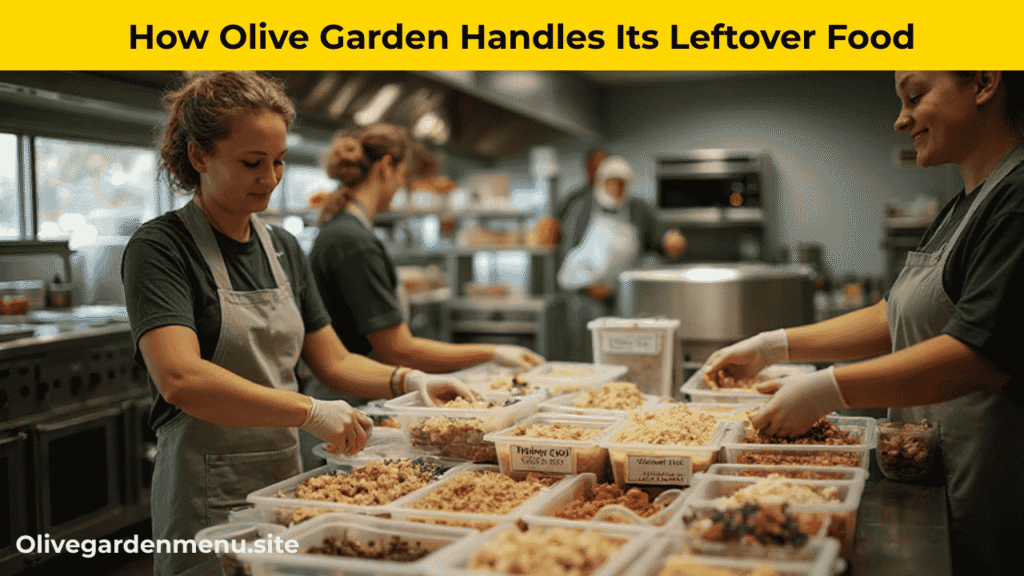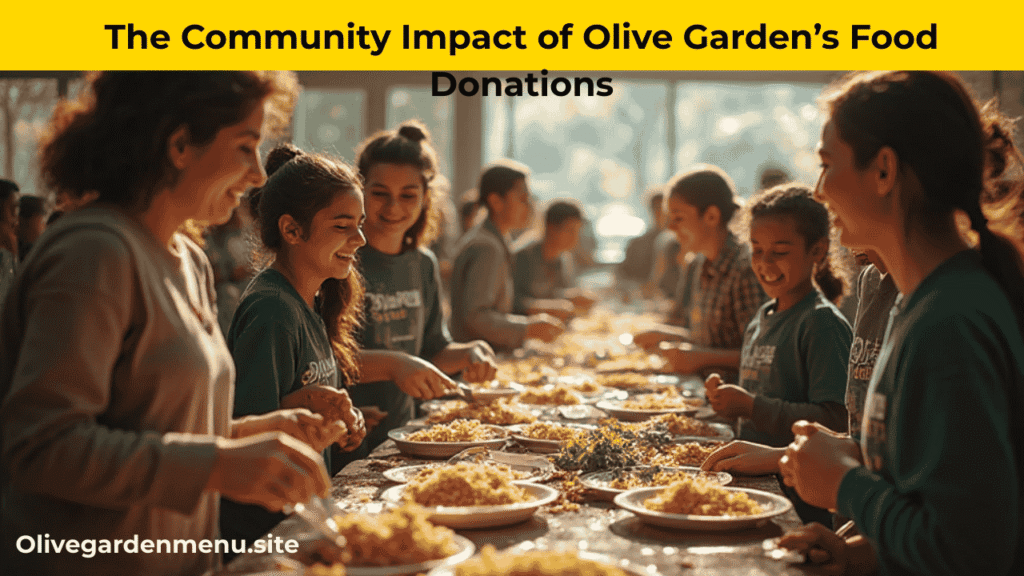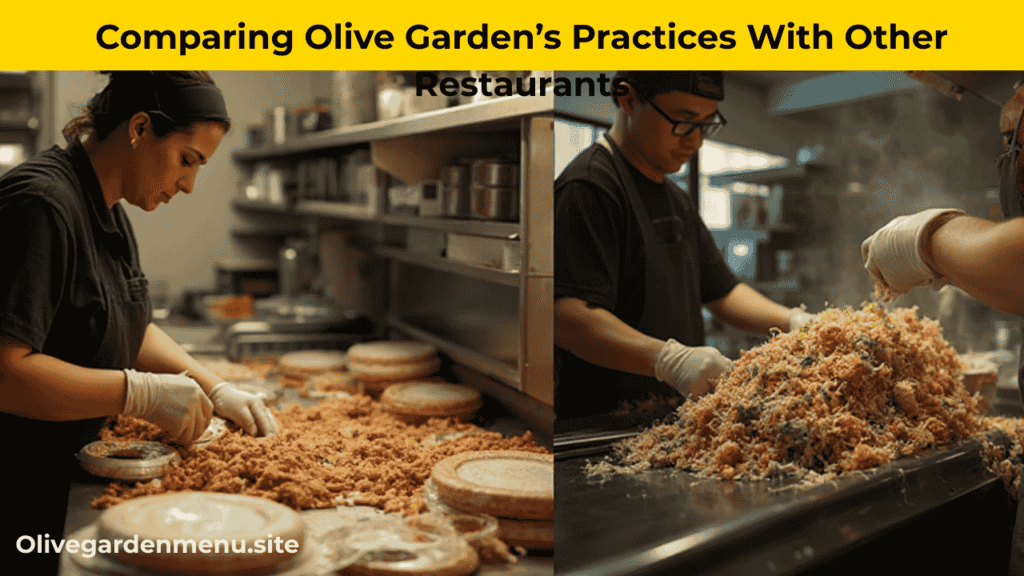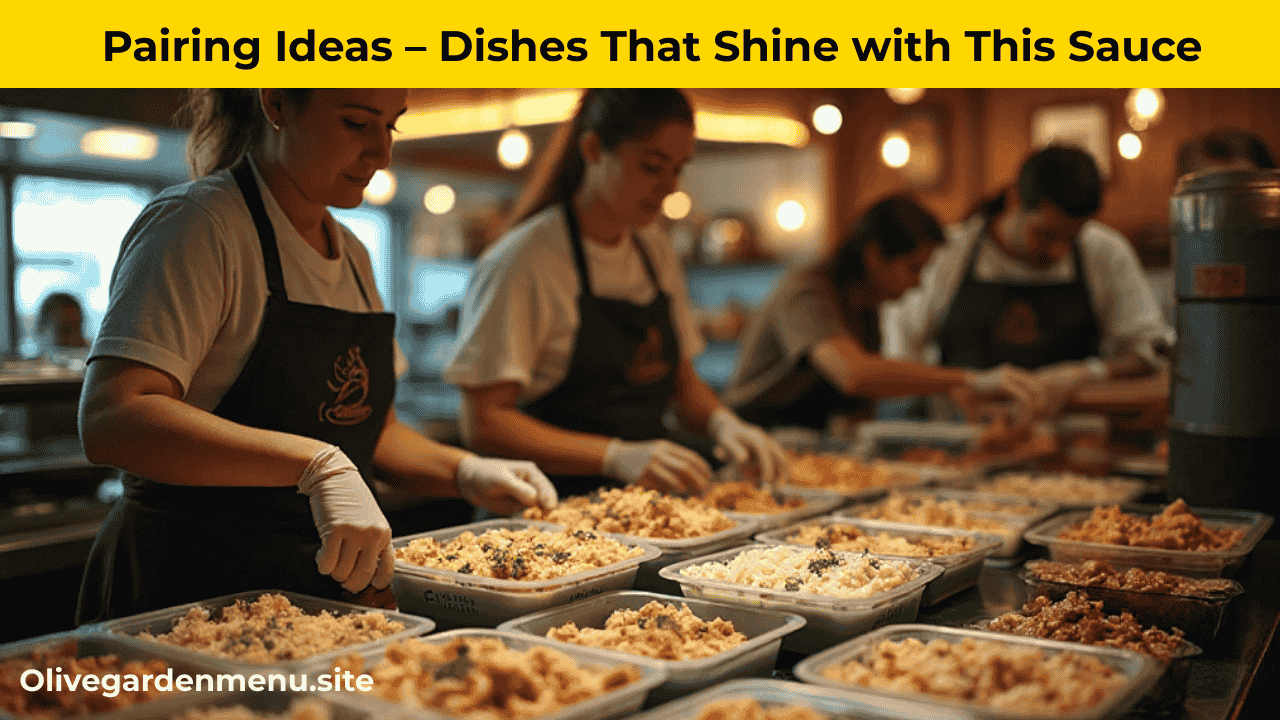When most of us walk out of a restaurant after a hearty meal, we rarely stop to think about what happens to the food that never gets served. I’ll be honest — I didn’t either, at least not until I learned how Olive Garden manages its leftovers. I always assumed that extra breadsticks, pasta, and soups at the end of the night simply ended up in the trash. But what Olive Garden actually does is far more inspiring.

Instead of letting good meals go to waste, they’ve built a system that channels this food back into the community. That discovery made me look at the restaurant in a new light. It’s not just about serving families at the table; it’s about extending that care to people who may not even step through their doors. What Olive Garden leftover food is more than practical — it’s wholesome, compassionate, and deeply needed today.
Why Olive Garden Cares About Reducing Food Waste
The Impact of Food Waste in the Restaurant Industry
Food waste is one of those hidden issues that restaurants struggle with daily. Across the U.S., millions of pounds of prepared meals and fresh ingredients are tossed away every single year. It’s not just a matter of throwing out dinner rolls; it’s the wasted labor, the water used to grow crops, the fuel to transport ingredients, and the energy spent cooking them. When food is thrown away, all those resources vanish with it. Having worked in kitchens before, I know firsthand how painful it is to see trays of untouched food get dumped. For a chain as large as Olive Garden, taking steps against waste doesn’t just make sense — it sets an example for the entire industry.
Olive Garden’s Commitment to Sustainability and Community
What makes Olive Garden different is that they don’t shy away from responsibility. They’ve committed themselves to sustainability by putting clear programs in place to minimize waste and maximize community support. Their philosophy is simple: food should nourish, not be wasted. Every restaurant participates in structured donation efforts, ensuring food reaches people who need it most. This isn’t just a corporate move for publicity; it’s something I’ve seen people in local communities genuinely appreciate. Families benefit, shelters get consistent support, and Olive Garden strengthens its role as more than just a dining option — it becomes a community partner.
How Olive Garden Handles Its Leftover Food

Food Donation Programs and Local Partnerships
Olive Garden has turned food donation into an organized system rather than an occasional good deed. Every location partners with local food banks and nonprofit organizations to make sure leftover meals find their way to tables outside the restaurant. This effort not only reduces waste but directly addresses hunger in nearby neighborhoods.
Here’s how Olive Garden’s process compares with many other restaurants:
| Step in the Process | Olive Garden’s Approach | Common Practice in Other Restaurants |
| Collection of Leftovers | Gathered daily before closing | Often discarded with regular waste |
| Food Quality Standards | Only safe, wholesome meals are packed | Rarely separated with safety checks |
| Partnerships | Direct partnerships with local food banks | Limited or no consistent partnerships |
| Frequency of Donations | Weekly scheduled donations in most locations | Occasional, not structured |
| Community Benefit | Families, shelters, and pantries receive meals | Minimal — most food never leaves the kitchen |
This level of consistency is what sets Olive Garden apart. They’ve created a routine that ensures communities get reliable food support rather than random, occasional drops.
Safety Standards in Donating Excess Meals
Of course, donating food isn’t as simple as boxing it up and sending it out the door. Safety is at the heart of Olive Garden’s process. Only food prepared under safe kitchen conditions, held at proper temperatures, and stored correctly is donated. Staff are trained to identify which items meet donation standards and which do not. For example, hot entrees are cooled down quickly and refrigerated before pickup, ensuring they stay fresh. This careful system protects the people receiving the meals, while also showing that Olive Garden values quality and dignity just as much as generosity.
What Happens to Ingredients That Can’t Be Donated
Not every leftover item qualifies for donation. Fresh produce past its peak, partially used ingredients, or items not safe to redistribute are handled differently. Instead of mindlessly discarding them, Olive Garden focuses on responsible disposal methods. Some ingredients are composted, others recycled where possible, and waste is minimized as much as regulations allow. By doing this, they make sure even non-donatable food has a reduced environmental impact.
The Community Impact of Olive Garden’s Food Donations

Helping Local Food Banks and Charities
The real story here is about the people who benefit. Local food banks often depend on partnerships with restaurants like Olive Garden to meet the growing demand for meals. These organizations receive hearty pastas, proteins, soups, and salads that help stock their shelves and kitchens. Volunteers often remark how donations from a well-known chain lift spirits — there’s comfort in familiar, restaurant-quality food. For families, it means enjoying a meal they might not otherwise be able to afford.
Stories of Families and Individuals Who Benefit
Behind every donated tray of lasagna or breadsticks is a personal story. I remember one food pantry volunteer telling me about a single mother who picked up donated Olive Garden meals for her kids. For her, it wasn’t just about the food; it was about giving her children something special and comforting in tough times. These stories are what truly highlight the impact. Olive Garden’s efforts don’t just fill plates — they restore a sense of dignity, community, and connection. Families in need get a chance to enjoy the same meals many of us have shared during celebrations, and that matters more than we often realize.
Comparing Olive Garden’s Practices With Other Restaurants

How Competitors Manage Leftover Food
Not every restaurant takes the same approach Olive Garden does. Many chains, especially smaller ones, lack structured programs for handling leftovers. In some cases, food is simply discarded at closing time due to concerns over safety, liability, or lack of partnerships with local charities. While a handful of restaurants participate in donation programs, they often do so inconsistently. A big reason is logistics: packaging, refrigeration, and coordinating pickups require planning and commitment. Without a dedicated system in place, most competitors can’t match the scale of Olive Garden’s efforts.
Why Olive Garden’s Approach Stands Out
Olive Garden sets itself apart by making food donations part of its everyday operations, not just an occasional gesture. Every restaurant location participates in the same program, ensuring consistency across the country. On top of that, their focus on food safety and community partnerships creates trust — both with the organizations they serve and the families who benefit. Where many restaurants see leftover food as a problem, Olive Garden sees it as an opportunity to give back. This difference in perspective is what makes their approach both wholesome and effective.
What Customers Can Learn From Olive Garden’s Approach
Tips to Reduce Food Waste at Home
The lessons Olive Garden applies in its kitchens can easily carry over to our homes. Some of the most practical ways to cut down waste include:
- Plan meals ahead: Buy only what you need for the week.
- Store food properly: Refrigerate or freeze leftovers quickly to keep them fresh.
- Repurpose leftovers: Turn last night’s pasta into a new casserole or soup.
- Donate when possible: Some communities allow individuals to share extra food through food banks or community fridges.
These simple steps help households cut costs and reduce waste while making a positive impact on the environment.
Supporting Restaurants That Care About Sustainability
Another takeaway is choosing to support businesses that take responsibility for their waste. By dining at restaurants like Olive Garden, customers indirectly contribute to local food banks and community programs. It’s a powerful reminder that our choices as diners can shape industry standards. The more we support restaurants that give back, the more likely others are to follow suit.
FINAL WORDS:
What Olive Garden does with leftover food isn’t just a behind-the-scenes process — it’s a reflection of their values. By committing to donations, prioritizing food safety, and reducing waste, they’ve proven that a national restaurant chain can make a real difference in local communities. For me, learning about these efforts has made dining at Olive Garden feel more meaningful. Every plate of pasta and every basket of breadsticks represents not just a meal for me, but also a commitment to feed others who may not be able to afford one. In a world where waste is too often ignored, Olive Garden has shown that compassion and responsibility can share the same table.
FAQs
Does Olive Garden really donate all leftover food?
Not all food can be donated, but Olive Garden makes sure that everything safe and wholesome goes to local food banks and charities. Items that don’t meet safety standards are responsibly discarded or recycled.
How does Olive Garden ensure food safety when donating?
Employees are trained to follow strict food safety guidelines. Hot meals are cooled and stored properly, while perishable items are refrigerated before being donated to ensure they remain safe to eat.
Which organizations receive Olive Garden’s food donations?
Olive Garden partners with local food banks, shelters, and nonprofit groups across the U.S. Each location works with organizations in its own community, ensuring meals directly support nearby families in need.
Does Olive Garden recycle or compost food waste too?
Yes. When food can’t be donated, Olive Garden uses recycling and composting programs where possible. This reduces environmental impact and keeps waste out of landfills.
How can customers support Olive Garden’s sustainability efforts?
The easiest way to support is by dining at Olive Garden, since their donation programs run at every restaurant. Customers can also help by reducing their own food waste at home and encouraging more restaurants to adopt similar programs.



